Project Integration: BSBPMG521 Homework Assignment Solution
VerifiedAdded on 2023/06/03
|14
|3782
|359
Homework Assignment
AI Summary
This assignment solution addresses the core concepts of project integration management, covering essential aspects such as project establishment, planning, execution, and stakeholder management. It delves into the links between projects and organizational strategies, describing key terms like project objectives, outcomes, and benefits. The solution outlines the process of formulating project charters, developing work breakdown structures (WBS), and identifying project interdependencies. It also explains methods for controlling and monitoring projects, aligning project plans with corporate objectives, and resolving stakeholder conflicts. The document provides detailed explanations and examples to illustrate these concepts, offering a comprehensive guide for understanding and applying project integration principles. This assignment is a valuable resource for students studying project management and seeking to improve their understanding of the subject, with Desklib providing additional study resources.
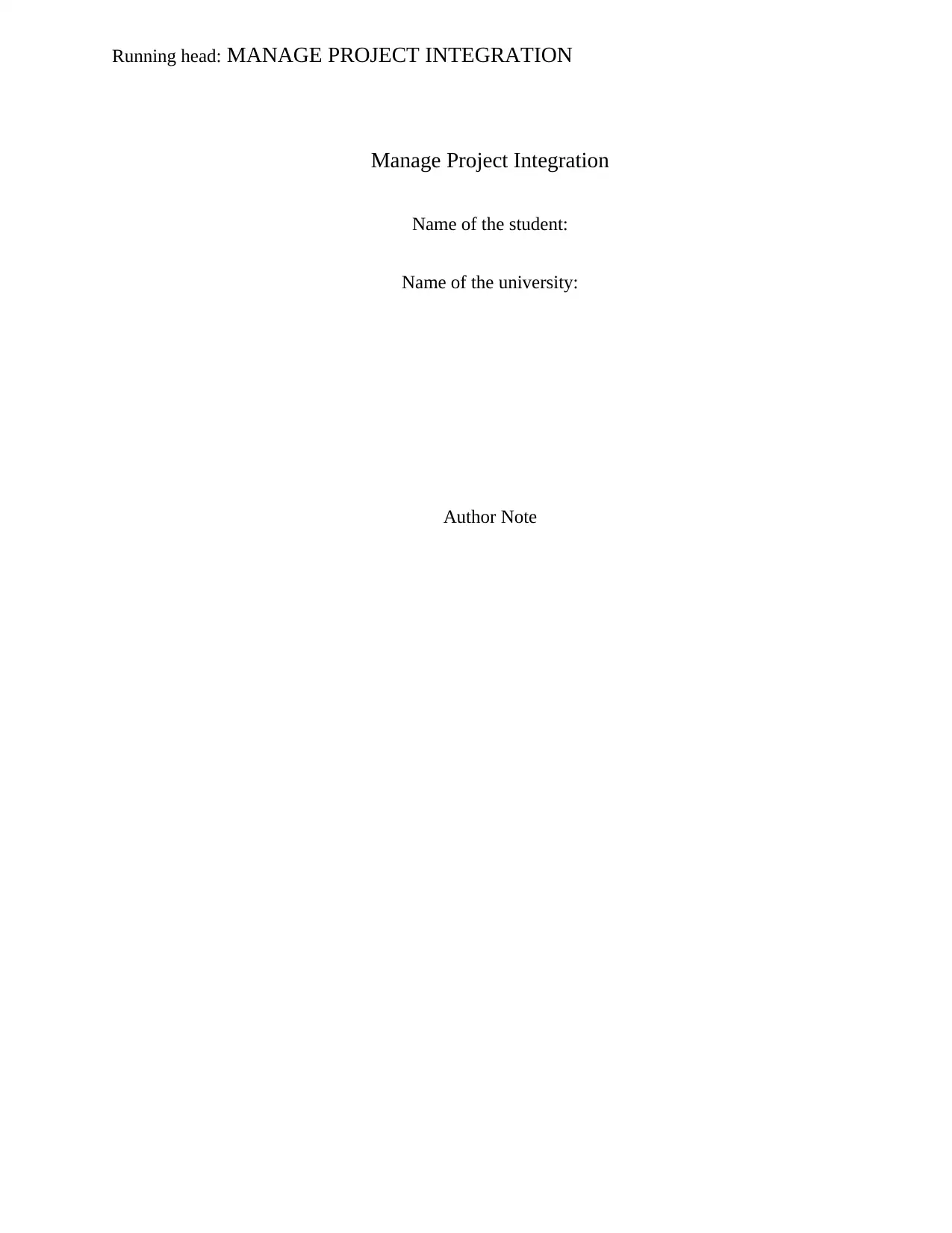
Running head: MANAGE PROJECT INTEGRATION
Manage Project Integration
Name of the student:
Name of the university:
Author Note
Manage Project Integration
Name of the student:
Name of the university:
Author Note
Paraphrase This Document
Need a fresh take? Get an instant paraphrase of this document with our AI Paraphraser
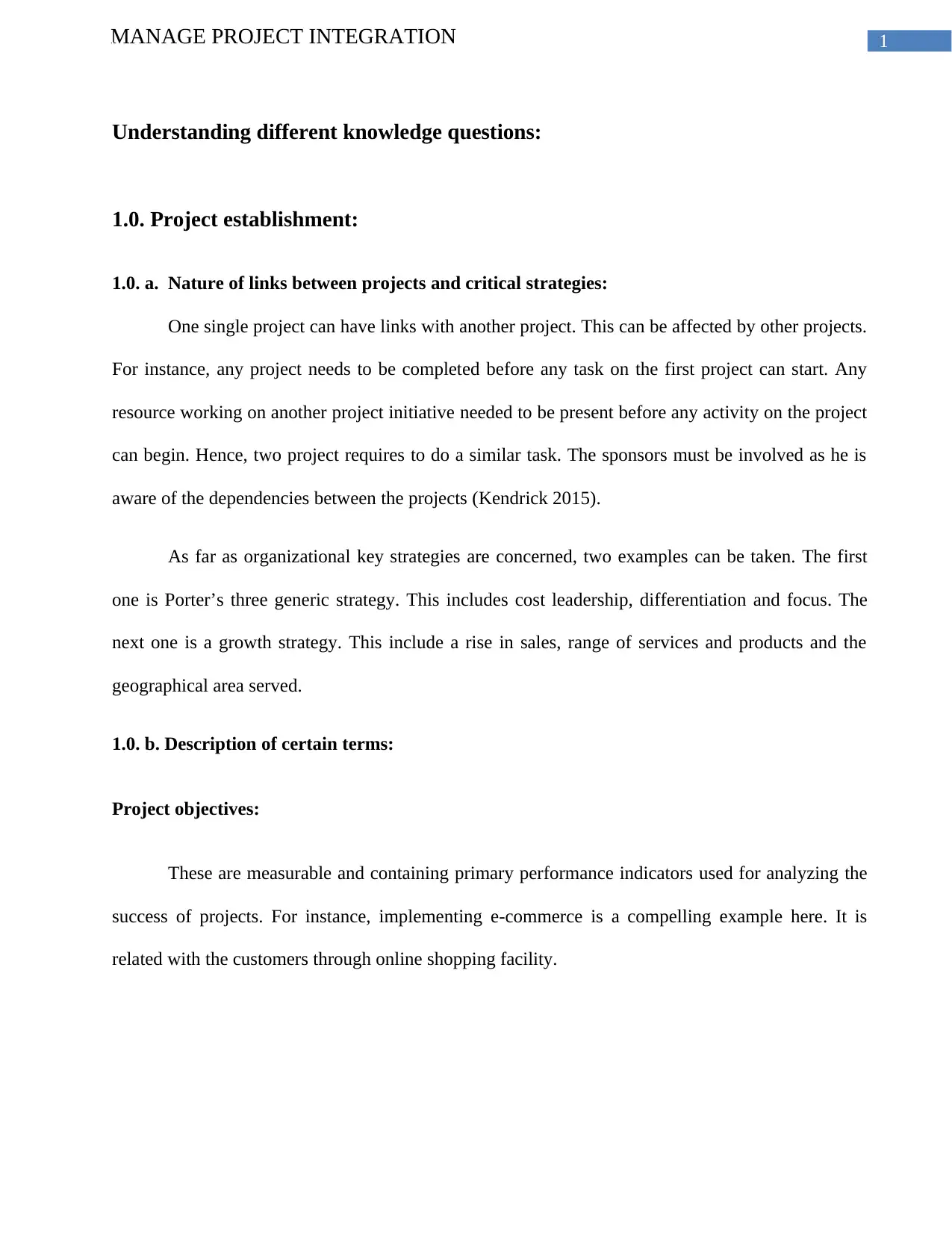
1MANAGE PROJECT INTEGRATION
Understanding different knowledge questions:
1.0. Project establishment:
1.0. a. Nature of links between projects and critical strategies:
One single project can have links with another project. This can be affected by other projects.
For instance, any project needs to be completed before any task on the first project can start. Any
resource working on another project initiative needed to be present before any activity on the project
can begin. Hence, two project requires to do a similar task. The sponsors must be involved as he is
aware of the dependencies between the projects (Kendrick 2015).
As far as organizational key strategies are concerned, two examples can be taken. The first
one is Porter’s three generic strategy. This includes cost leadership, differentiation and focus. The
next one is a growth strategy. This include a rise in sales, range of services and products and the
geographical area served.
1.0. b. Description of certain terms:
Project objectives:
These are measurable and containing primary performance indicators used for analyzing the
success of projects. For instance, implementing e-commerce is a compelling example here. It is
related with the customers through online shopping facility.
Understanding different knowledge questions:
1.0. Project establishment:
1.0. a. Nature of links between projects and critical strategies:
One single project can have links with another project. This can be affected by other projects.
For instance, any project needs to be completed before any task on the first project can start. Any
resource working on another project initiative needed to be present before any activity on the project
can begin. Hence, two project requires to do a similar task. The sponsors must be involved as he is
aware of the dependencies between the projects (Kendrick 2015).
As far as organizational key strategies are concerned, two examples can be taken. The first
one is Porter’s three generic strategy. This includes cost leadership, differentiation and focus. The
next one is a growth strategy. This include a rise in sales, range of services and products and the
geographical area served.
1.0. b. Description of certain terms:
Project objectives:
These are measurable and containing primary performance indicators used for analyzing the
success of projects. For instance, implementing e-commerce is a compelling example here. It is
related with the customers through online shopping facility.
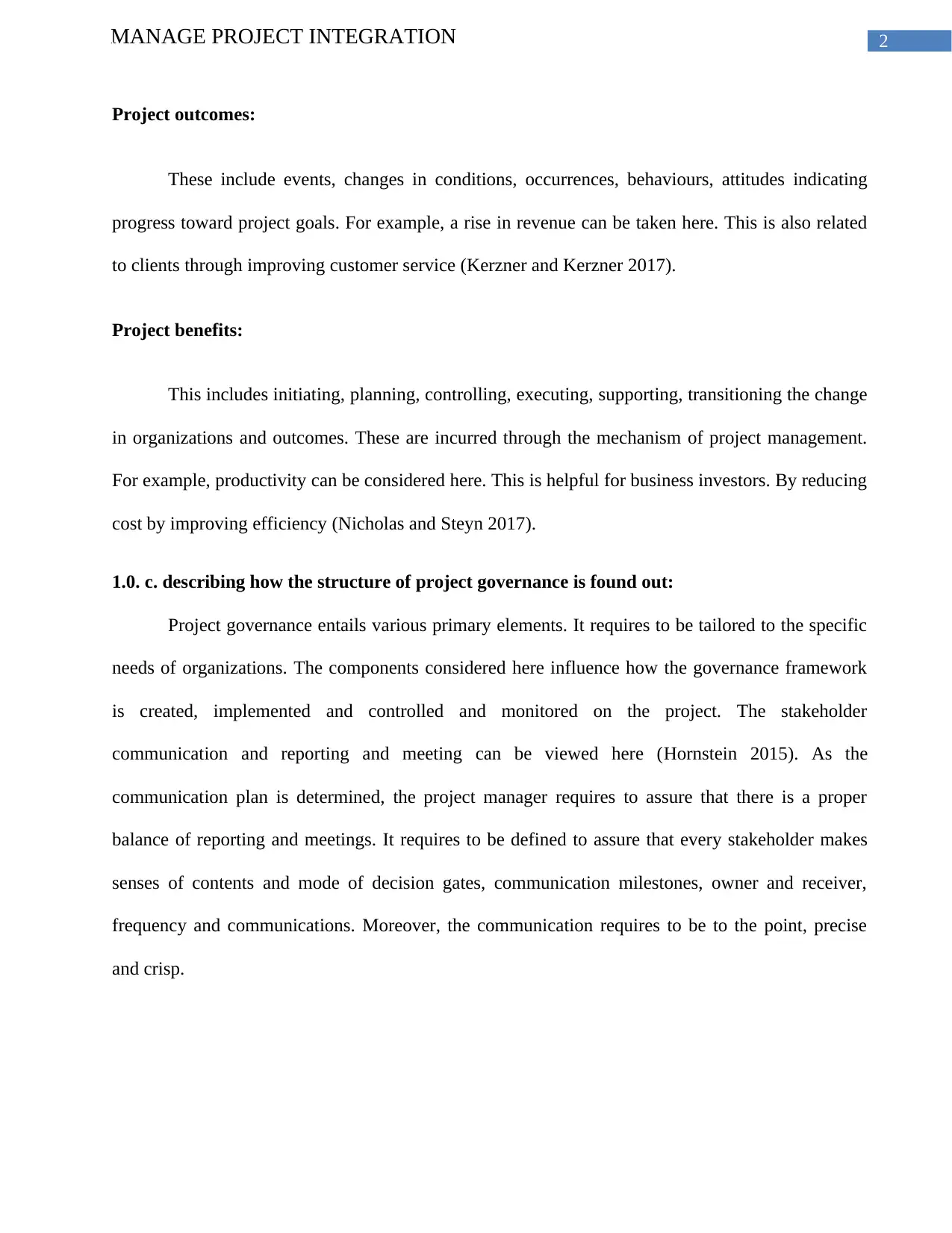
2MANAGE PROJECT INTEGRATION
Project outcomes:
These include events, changes in conditions, occurrences, behaviours, attitudes indicating
progress toward project goals. For example, a rise in revenue can be taken here. This is also related
to clients through improving customer service (Kerzner and Kerzner 2017).
Project benefits:
This includes initiating, planning, controlling, executing, supporting, transitioning the change
in organizations and outcomes. These are incurred through the mechanism of project management.
For example, productivity can be considered here. This is helpful for business investors. By reducing
cost by improving efficiency (Nicholas and Steyn 2017).
1.0. c. describing how the structure of project governance is found out:
Project governance entails various primary elements. It requires to be tailored to the specific
needs of organizations. The components considered here influence how the governance framework
is created, implemented and controlled and monitored on the project. The stakeholder
communication and reporting and meeting can be viewed here (Hornstein 2015). As the
communication plan is determined, the project manager requires to assure that there is a proper
balance of reporting and meetings. It requires to be defined to assure that every stakeholder makes
senses of contents and mode of decision gates, communication milestones, owner and receiver,
frequency and communications. Moreover, the communication requires to be to the point, precise
and crisp.
Project outcomes:
These include events, changes in conditions, occurrences, behaviours, attitudes indicating
progress toward project goals. For example, a rise in revenue can be taken here. This is also related
to clients through improving customer service (Kerzner and Kerzner 2017).
Project benefits:
This includes initiating, planning, controlling, executing, supporting, transitioning the change
in organizations and outcomes. These are incurred through the mechanism of project management.
For example, productivity can be considered here. This is helpful for business investors. By reducing
cost by improving efficiency (Nicholas and Steyn 2017).
1.0. c. describing how the structure of project governance is found out:
Project governance entails various primary elements. It requires to be tailored to the specific
needs of organizations. The components considered here influence how the governance framework
is created, implemented and controlled and monitored on the project. The stakeholder
communication and reporting and meeting can be viewed here (Hornstein 2015). As the
communication plan is determined, the project manager requires to assure that there is a proper
balance of reporting and meetings. It requires to be defined to assure that every stakeholder makes
senses of contents and mode of decision gates, communication milestones, owner and receiver,
frequency and communications. Moreover, the communication requires to be to the point, precise
and crisp.
⊘ This is a preview!⊘
Do you want full access?
Subscribe today to unlock all pages.

Trusted by 1+ million students worldwide
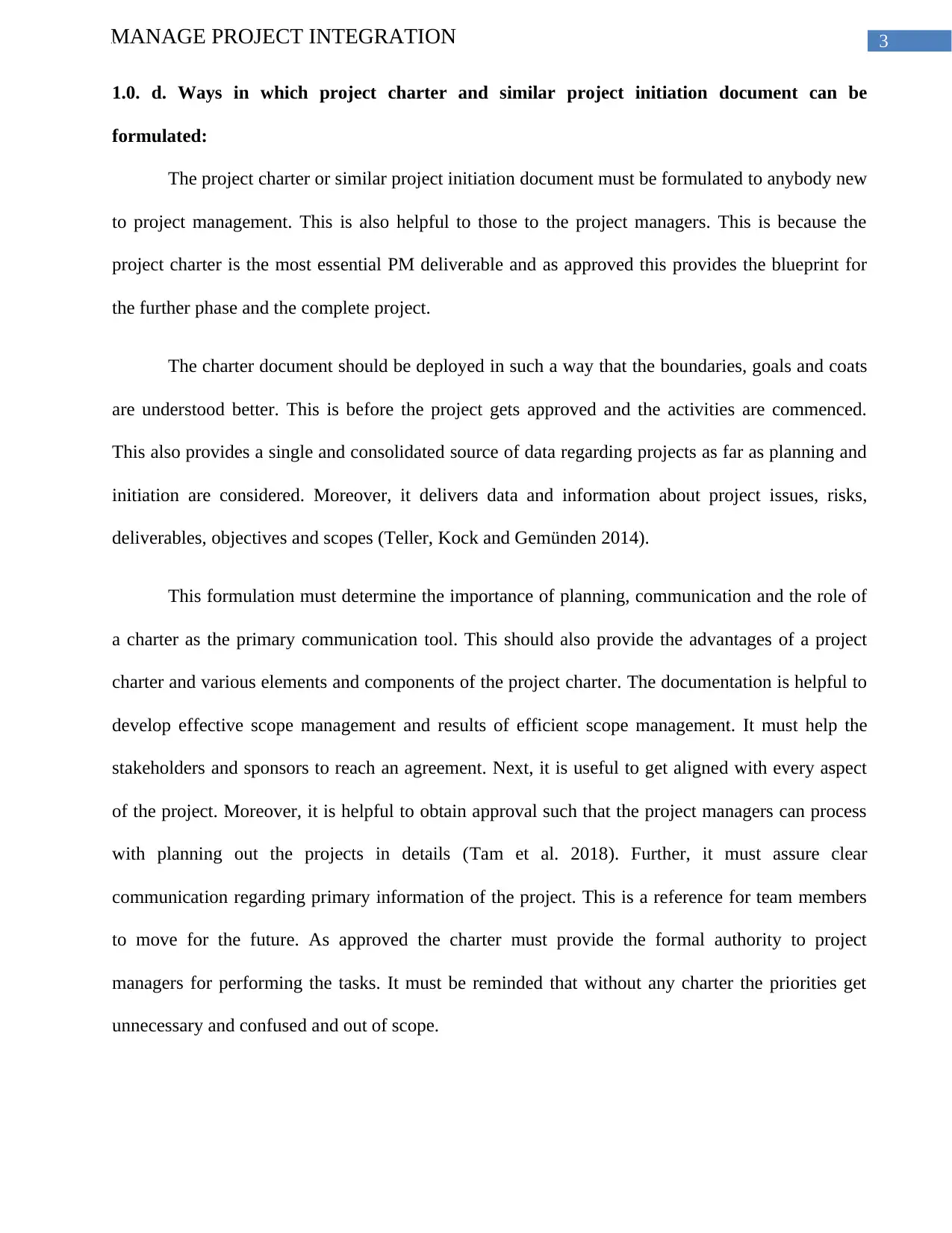
3MANAGE PROJECT INTEGRATION
1.0. d. Ways in which project charter and similar project initiation document can be
formulated:
The project charter or similar project initiation document must be formulated to anybody new
to project management. This is also helpful to those to the project managers. This is because the
project charter is the most essential PM deliverable and as approved this provides the blueprint for
the further phase and the complete project.
The charter document should be deployed in such a way that the boundaries, goals and coats
are understood better. This is before the project gets approved and the activities are commenced.
This also provides a single and consolidated source of data regarding projects as far as planning and
initiation are considered. Moreover, it delivers data and information about project issues, risks,
deliverables, objectives and scopes (Teller, Kock and Gemünden 2014).
This formulation must determine the importance of planning, communication and the role of
a charter as the primary communication tool. This should also provide the advantages of a project
charter and various elements and components of the project charter. The documentation is helpful to
develop effective scope management and results of efficient scope management. It must help the
stakeholders and sponsors to reach an agreement. Next, it is useful to get aligned with every aspect
of the project. Moreover, it is helpful to obtain approval such that the project managers can process
with planning out the projects in details (Tam et al. 2018). Further, it must assure clear
communication regarding primary information of the project. This is a reference for team members
to move for the future. As approved the charter must provide the formal authority to project
managers for performing the tasks. It must be reminded that without any charter the priorities get
unnecessary and confused and out of scope.
1.0. d. Ways in which project charter and similar project initiation document can be
formulated:
The project charter or similar project initiation document must be formulated to anybody new
to project management. This is also helpful to those to the project managers. This is because the
project charter is the most essential PM deliverable and as approved this provides the blueprint for
the further phase and the complete project.
The charter document should be deployed in such a way that the boundaries, goals and coats
are understood better. This is before the project gets approved and the activities are commenced.
This also provides a single and consolidated source of data regarding projects as far as planning and
initiation are considered. Moreover, it delivers data and information about project issues, risks,
deliverables, objectives and scopes (Teller, Kock and Gemünden 2014).
This formulation must determine the importance of planning, communication and the role of
a charter as the primary communication tool. This should also provide the advantages of a project
charter and various elements and components of the project charter. The documentation is helpful to
develop effective scope management and results of efficient scope management. It must help the
stakeholders and sponsors to reach an agreement. Next, it is useful to get aligned with every aspect
of the project. Moreover, it is helpful to obtain approval such that the project managers can process
with planning out the projects in details (Tam et al. 2018). Further, it must assure clear
communication regarding primary information of the project. This is a reference for team members
to move for the future. As approved the charter must provide the formal authority to project
managers for performing the tasks. It must be reminded that without any charter the priorities get
unnecessary and confused and out of scope.
Paraphrase This Document
Need a fresh take? Get an instant paraphrase of this document with our AI Paraphraser
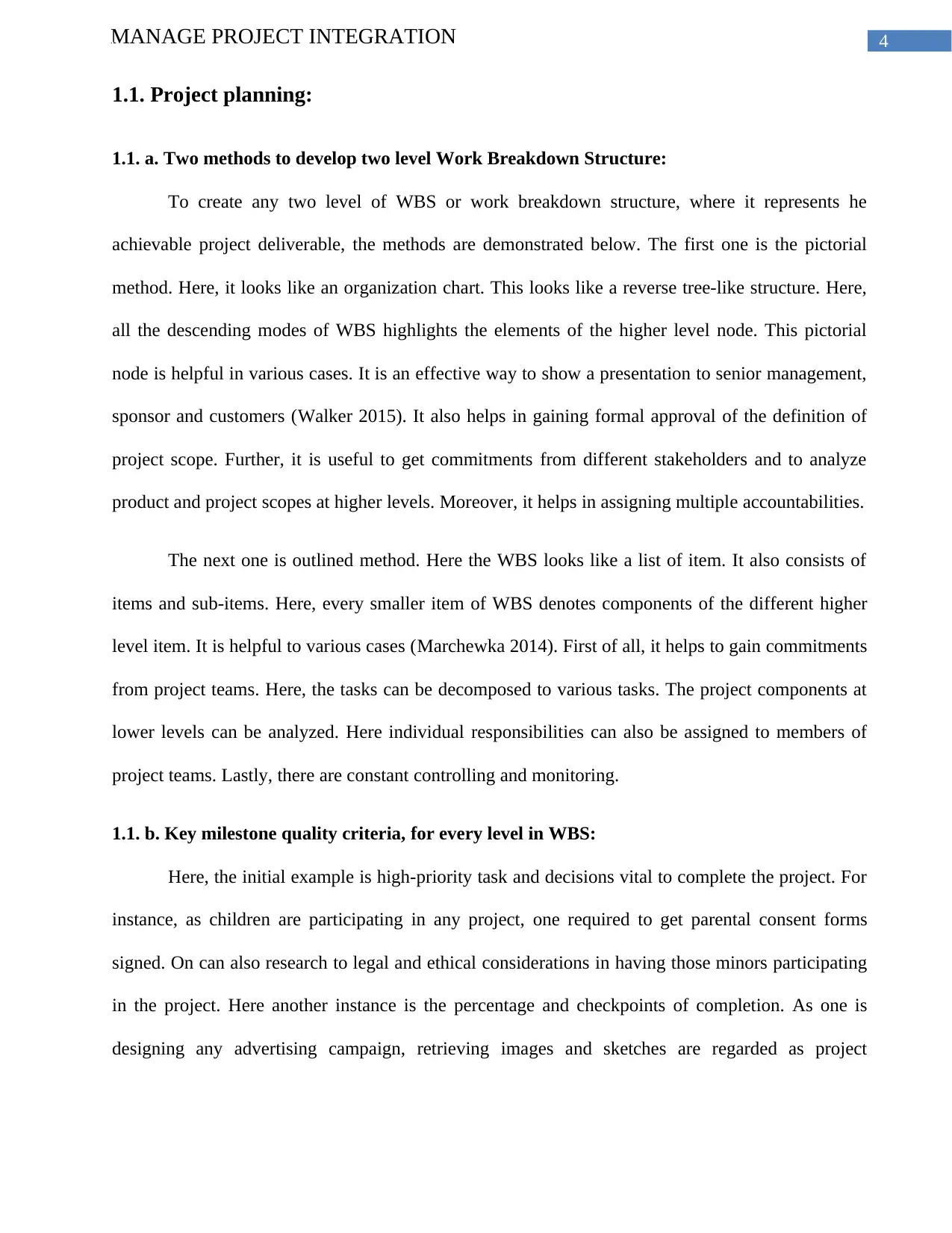
4MANAGE PROJECT INTEGRATION
1.1. Project planning:
1.1. a. Two methods to develop two level Work Breakdown Structure:
To create any two level of WBS or work breakdown structure, where it represents he
achievable project deliverable, the methods are demonstrated below. The first one is the pictorial
method. Here, it looks like an organization chart. This looks like a reverse tree-like structure. Here,
all the descending modes of WBS highlights the elements of the higher level node. This pictorial
node is helpful in various cases. It is an effective way to show a presentation to senior management,
sponsor and customers (Walker 2015). It also helps in gaining formal approval of the definition of
project scope. Further, it is useful to get commitments from different stakeholders and to analyze
product and project scopes at higher levels. Moreover, it helps in assigning multiple accountabilities.
The next one is outlined method. Here the WBS looks like a list of item. It also consists of
items and sub-items. Here, every smaller item of WBS denotes components of the different higher
level item. It is helpful to various cases (Marchewka 2014). First of all, it helps to gain commitments
from project teams. Here, the tasks can be decomposed to various tasks. The project components at
lower levels can be analyzed. Here individual responsibilities can also be assigned to members of
project teams. Lastly, there are constant controlling and monitoring.
1.1. b. Key milestone quality criteria, for every level in WBS:
Here, the initial example is high-priority task and decisions vital to complete the project. For
instance, as children are participating in any project, one required to get parental consent forms
signed. On can also research to legal and ethical considerations in having those minors participating
in the project. Here another instance is the percentage and checkpoints of completion. As one is
designing any advertising campaign, retrieving images and sketches are regarded as project
1.1. Project planning:
1.1. a. Two methods to develop two level Work Breakdown Structure:
To create any two level of WBS or work breakdown structure, where it represents he
achievable project deliverable, the methods are demonstrated below. The first one is the pictorial
method. Here, it looks like an organization chart. This looks like a reverse tree-like structure. Here,
all the descending modes of WBS highlights the elements of the higher level node. This pictorial
node is helpful in various cases. It is an effective way to show a presentation to senior management,
sponsor and customers (Walker 2015). It also helps in gaining formal approval of the definition of
project scope. Further, it is useful to get commitments from different stakeholders and to analyze
product and project scopes at higher levels. Moreover, it helps in assigning multiple accountabilities.
The next one is outlined method. Here the WBS looks like a list of item. It also consists of
items and sub-items. Here, every smaller item of WBS denotes components of the different higher
level item. It is helpful to various cases (Marchewka 2014). First of all, it helps to gain commitments
from project teams. Here, the tasks can be decomposed to various tasks. The project components at
lower levels can be analyzed. Here individual responsibilities can also be assigned to members of
project teams. Lastly, there are constant controlling and monitoring.
1.1. b. Key milestone quality criteria, for every level in WBS:
Here, the initial example is high-priority task and decisions vital to complete the project. For
instance, as children are participating in any project, one required to get parental consent forms
signed. On can also research to legal and ethical considerations in having those minors participating
in the project. Here another instance is the percentage and checkpoints of completion. As one is
designing any advertising campaign, retrieving images and sketches are regarded as project
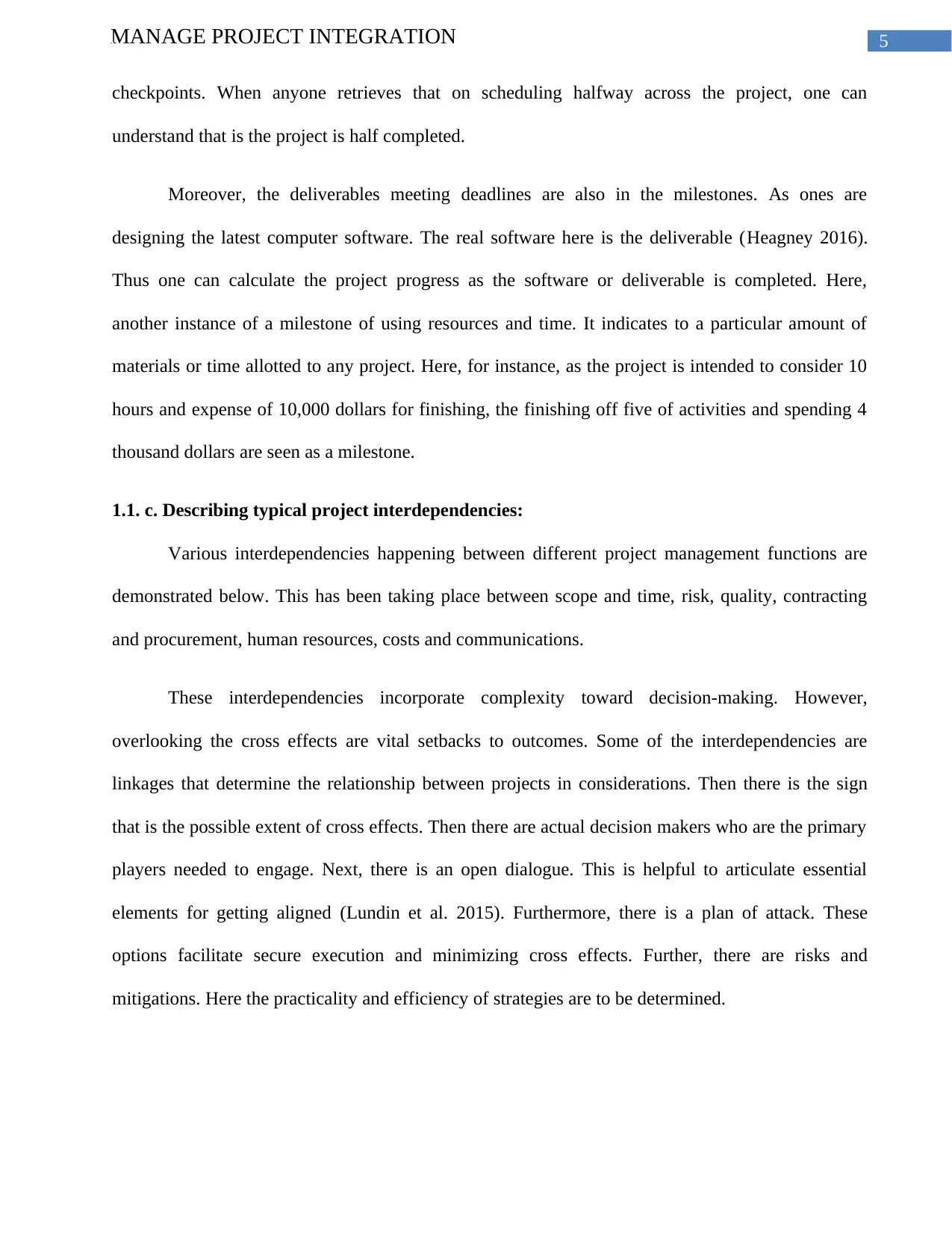
5MANAGE PROJECT INTEGRATION
checkpoints. When anyone retrieves that on scheduling halfway across the project, one can
understand that is the project is half completed.
Moreover, the deliverables meeting deadlines are also in the milestones. As ones are
designing the latest computer software. The real software here is the deliverable (Heagney 2016).
Thus one can calculate the project progress as the software or deliverable is completed. Here,
another instance of a milestone of using resources and time. It indicates to a particular amount of
materials or time allotted to any project. Here, for instance, as the project is intended to consider 10
hours and expense of 10,000 dollars for finishing, the finishing off five of activities and spending 4
thousand dollars are seen as a milestone.
1.1. c. Describing typical project interdependencies:
Various interdependencies happening between different project management functions are
demonstrated below. This has been taking place between scope and time, risk, quality, contracting
and procurement, human resources, costs and communications.
These interdependencies incorporate complexity toward decision-making. However,
overlooking the cross effects are vital setbacks to outcomes. Some of the interdependencies are
linkages that determine the relationship between projects in considerations. Then there is the sign
that is the possible extent of cross effects. Then there are actual decision makers who are the primary
players needed to engage. Next, there is an open dialogue. This is helpful to articulate essential
elements for getting aligned (Lundin et al. 2015). Furthermore, there is a plan of attack. These
options facilitate secure execution and minimizing cross effects. Further, there are risks and
mitigations. Here the practicality and efficiency of strategies are to be determined.
checkpoints. When anyone retrieves that on scheduling halfway across the project, one can
understand that is the project is half completed.
Moreover, the deliverables meeting deadlines are also in the milestones. As ones are
designing the latest computer software. The real software here is the deliverable (Heagney 2016).
Thus one can calculate the project progress as the software or deliverable is completed. Here,
another instance of a milestone of using resources and time. It indicates to a particular amount of
materials or time allotted to any project. Here, for instance, as the project is intended to consider 10
hours and expense of 10,000 dollars for finishing, the finishing off five of activities and spending 4
thousand dollars are seen as a milestone.
1.1. c. Describing typical project interdependencies:
Various interdependencies happening between different project management functions are
demonstrated below. This has been taking place between scope and time, risk, quality, contracting
and procurement, human resources, costs and communications.
These interdependencies incorporate complexity toward decision-making. However,
overlooking the cross effects are vital setbacks to outcomes. Some of the interdependencies are
linkages that determine the relationship between projects in considerations. Then there is the sign
that is the possible extent of cross effects. Then there are actual decision makers who are the primary
players needed to engage. Next, there is an open dialogue. This is helpful to articulate essential
elements for getting aligned (Lundin et al. 2015). Furthermore, there is a plan of attack. These
options facilitate secure execution and minimizing cross effects. Further, there are risks and
mitigations. Here the practicality and efficiency of strategies are to be determined.
⊘ This is a preview!⊘
Do you want full access?
Subscribe today to unlock all pages.

Trusted by 1+ million students worldwide
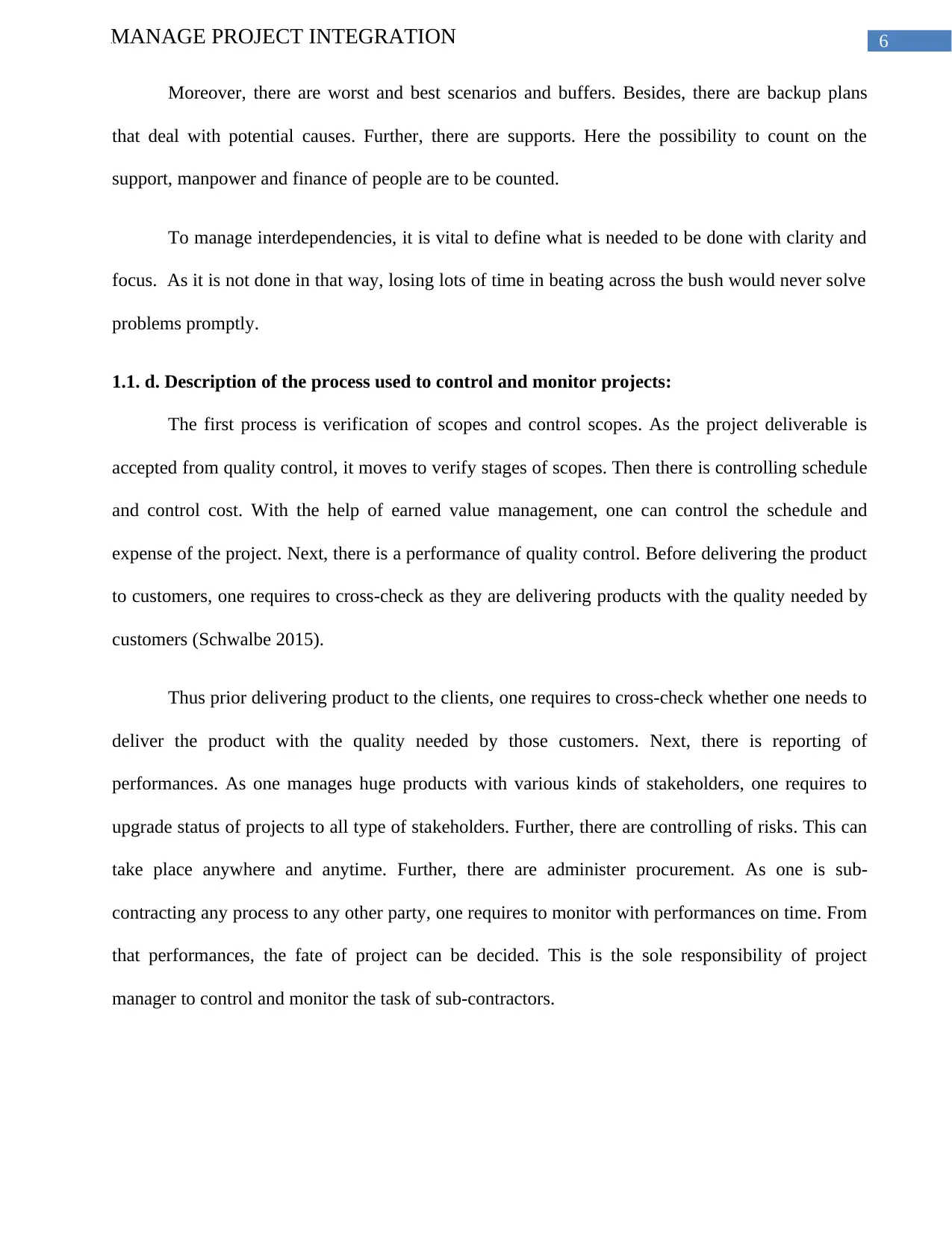
6MANAGE PROJECT INTEGRATION
Moreover, there are worst and best scenarios and buffers. Besides, there are backup plans
that deal with potential causes. Further, there are supports. Here the possibility to count on the
support, manpower and finance of people are to be counted.
To manage interdependencies, it is vital to define what is needed to be done with clarity and
focus. As it is not done in that way, losing lots of time in beating across the bush would never solve
problems promptly.
1.1. d. Description of the process used to control and monitor projects:
The first process is verification of scopes and control scopes. As the project deliverable is
accepted from quality control, it moves to verify stages of scopes. Then there is controlling schedule
and control cost. With the help of earned value management, one can control the schedule and
expense of the project. Next, there is a performance of quality control. Before delivering the product
to customers, one requires to cross-check as they are delivering products with the quality needed by
customers (Schwalbe 2015).
Thus prior delivering product to the clients, one requires to cross-check whether one needs to
deliver the product with the quality needed by those customers. Next, there is reporting of
performances. As one manages huge products with various kinds of stakeholders, one requires to
upgrade status of projects to all type of stakeholders. Further, there are controlling of risks. This can
take place anywhere and anytime. Further, there are administer procurement. As one is sub-
contracting any process to any other party, one requires to monitor with performances on time. From
that performances, the fate of project can be decided. This is the sole responsibility of project
manager to control and monitor the task of sub-contractors.
Moreover, there are worst and best scenarios and buffers. Besides, there are backup plans
that deal with potential causes. Further, there are supports. Here the possibility to count on the
support, manpower and finance of people are to be counted.
To manage interdependencies, it is vital to define what is needed to be done with clarity and
focus. As it is not done in that way, losing lots of time in beating across the bush would never solve
problems promptly.
1.1. d. Description of the process used to control and monitor projects:
The first process is verification of scopes and control scopes. As the project deliverable is
accepted from quality control, it moves to verify stages of scopes. Then there is controlling schedule
and control cost. With the help of earned value management, one can control the schedule and
expense of the project. Next, there is a performance of quality control. Before delivering the product
to customers, one requires to cross-check as they are delivering products with the quality needed by
customers (Schwalbe 2015).
Thus prior delivering product to the clients, one requires to cross-check whether one needs to
deliver the product with the quality needed by those customers. Next, there is reporting of
performances. As one manages huge products with various kinds of stakeholders, one requires to
upgrade status of projects to all type of stakeholders. Further, there are controlling of risks. This can
take place anywhere and anytime. Further, there are administer procurement. As one is sub-
contracting any process to any other party, one requires to monitor with performances on time. From
that performances, the fate of project can be decided. This is the sole responsibility of project
manager to control and monitor the task of sub-contractors.
Paraphrase This Document
Need a fresh take? Get an instant paraphrase of this document with our AI Paraphraser
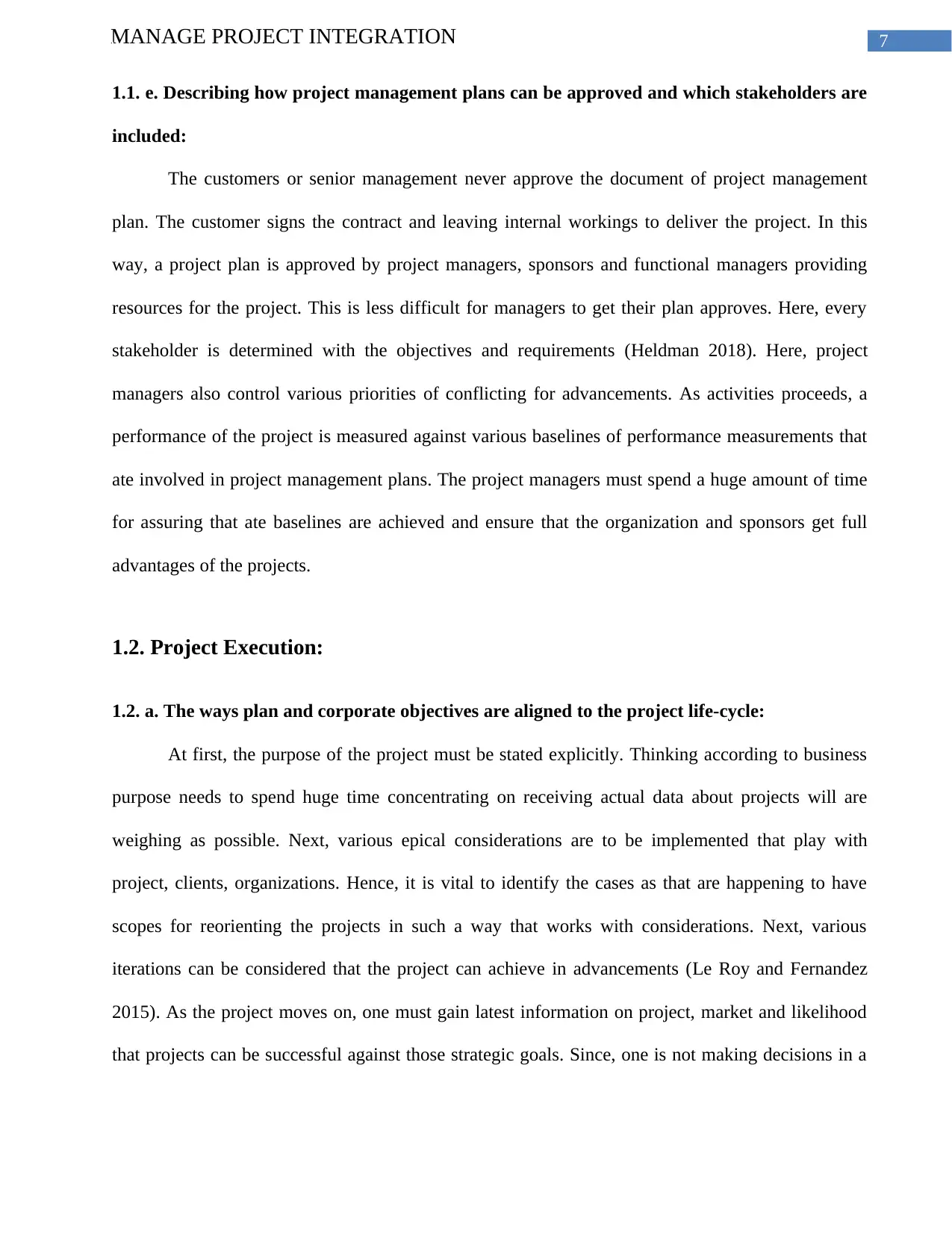
7MANAGE PROJECT INTEGRATION
1.1. e. Describing how project management plans can be approved and which stakeholders are
included:
The customers or senior management never approve the document of project management
plan. The customer signs the contract and leaving internal workings to deliver the project. In this
way, a project plan is approved by project managers, sponsors and functional managers providing
resources for the project. This is less difficult for managers to get their plan approves. Here, every
stakeholder is determined with the objectives and requirements (Heldman 2018). Here, project
managers also control various priorities of conflicting for advancements. As activities proceeds, a
performance of the project is measured against various baselines of performance measurements that
ate involved in project management plans. The project managers must spend a huge amount of time
for assuring that ate baselines are achieved and ensure that the organization and sponsors get full
advantages of the projects.
1.2. Project Execution:
1.2. a. The ways plan and corporate objectives are aligned to the project life-cycle:
At first, the purpose of the project must be stated explicitly. Thinking according to business
purpose needs to spend huge time concentrating on receiving actual data about projects will are
weighing as possible. Next, various epical considerations are to be implemented that play with
project, clients, organizations. Hence, it is vital to identify the cases as that are happening to have
scopes for reorienting the projects in such a way that works with considerations. Next, various
iterations can be considered that the project can achieve in advancements (Le Roy and Fernandez
2015). As the project moves on, one must gain latest information on project, market and likelihood
that projects can be successful against those strategic goals. Since, one is not making decisions in a
1.1. e. Describing how project management plans can be approved and which stakeholders are
included:
The customers or senior management never approve the document of project management
plan. The customer signs the contract and leaving internal workings to deliver the project. In this
way, a project plan is approved by project managers, sponsors and functional managers providing
resources for the project. This is less difficult for managers to get their plan approves. Here, every
stakeholder is determined with the objectives and requirements (Heldman 2018). Here, project
managers also control various priorities of conflicting for advancements. As activities proceeds, a
performance of the project is measured against various baselines of performance measurements that
ate involved in project management plans. The project managers must spend a huge amount of time
for assuring that ate baselines are achieved and ensure that the organization and sponsors get full
advantages of the projects.
1.2. Project Execution:
1.2. a. The ways plan and corporate objectives are aligned to the project life-cycle:
At first, the purpose of the project must be stated explicitly. Thinking according to business
purpose needs to spend huge time concentrating on receiving actual data about projects will are
weighing as possible. Next, various epical considerations are to be implemented that play with
project, clients, organizations. Hence, it is vital to identify the cases as that are happening to have
scopes for reorienting the projects in such a way that works with considerations. Next, various
iterations can be considered that the project can achieve in advancements (Le Roy and Fernandez
2015). As the project moves on, one must gain latest information on project, market and likelihood
that projects can be successful against those strategic goals. Since, one is not making decisions in a
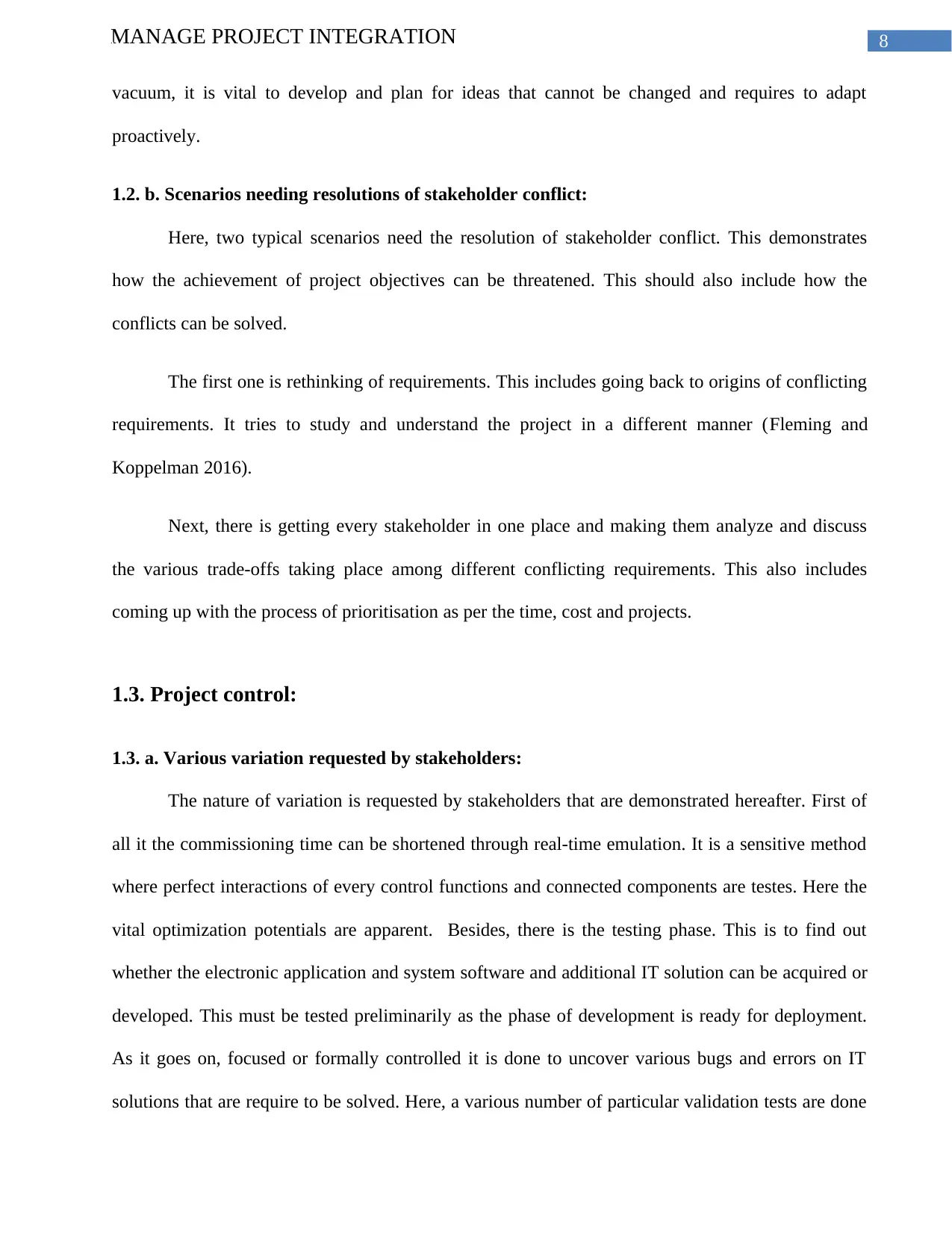
8MANAGE PROJECT INTEGRATION
vacuum, it is vital to develop and plan for ideas that cannot be changed and requires to adapt
proactively.
1.2. b. Scenarios needing resolutions of stakeholder conflict:
Here, two typical scenarios need the resolution of stakeholder conflict. This demonstrates
how the achievement of project objectives can be threatened. This should also include how the
conflicts can be solved.
The first one is rethinking of requirements. This includes going back to origins of conflicting
requirements. It tries to study and understand the project in a different manner (Fleming and
Koppelman 2016).
Next, there is getting every stakeholder in one place and making them analyze and discuss
the various trade-offs taking place among different conflicting requirements. This also includes
coming up with the process of prioritisation as per the time, cost and projects.
1.3. Project control:
1.3. a. Various variation requested by stakeholders:
The nature of variation is requested by stakeholders that are demonstrated hereafter. First of
all it the commissioning time can be shortened through real-time emulation. It is a sensitive method
where perfect interactions of every control functions and connected components are testes. Here the
vital optimization potentials are apparent. Besides, there is the testing phase. This is to find out
whether the electronic application and system software and additional IT solution can be acquired or
developed. This must be tested preliminarily as the phase of development is ready for deployment.
As it goes on, focused or formally controlled it is done to uncover various bugs and errors on IT
solutions that are require to be solved. Here, a various number of particular validation tests are done
vacuum, it is vital to develop and plan for ideas that cannot be changed and requires to adapt
proactively.
1.2. b. Scenarios needing resolutions of stakeholder conflict:
Here, two typical scenarios need the resolution of stakeholder conflict. This demonstrates
how the achievement of project objectives can be threatened. This should also include how the
conflicts can be solved.
The first one is rethinking of requirements. This includes going back to origins of conflicting
requirements. It tries to study and understand the project in a different manner (Fleming and
Koppelman 2016).
Next, there is getting every stakeholder in one place and making them analyze and discuss
the various trade-offs taking place among different conflicting requirements. This also includes
coming up with the process of prioritisation as per the time, cost and projects.
1.3. Project control:
1.3. a. Various variation requested by stakeholders:
The nature of variation is requested by stakeholders that are demonstrated hereafter. First of
all it the commissioning time can be shortened through real-time emulation. It is a sensitive method
where perfect interactions of every control functions and connected components are testes. Here the
vital optimization potentials are apparent. Besides, there is the testing phase. This is to find out
whether the electronic application and system software and additional IT solution can be acquired or
developed. This must be tested preliminarily as the phase of development is ready for deployment.
As it goes on, focused or formally controlled it is done to uncover various bugs and errors on IT
solutions that are require to be solved. Here, a various number of particular validation tests are done
⊘ This is a preview!⊘
Do you want full access?
Subscribe today to unlock all pages.

Trusted by 1+ million students worldwide
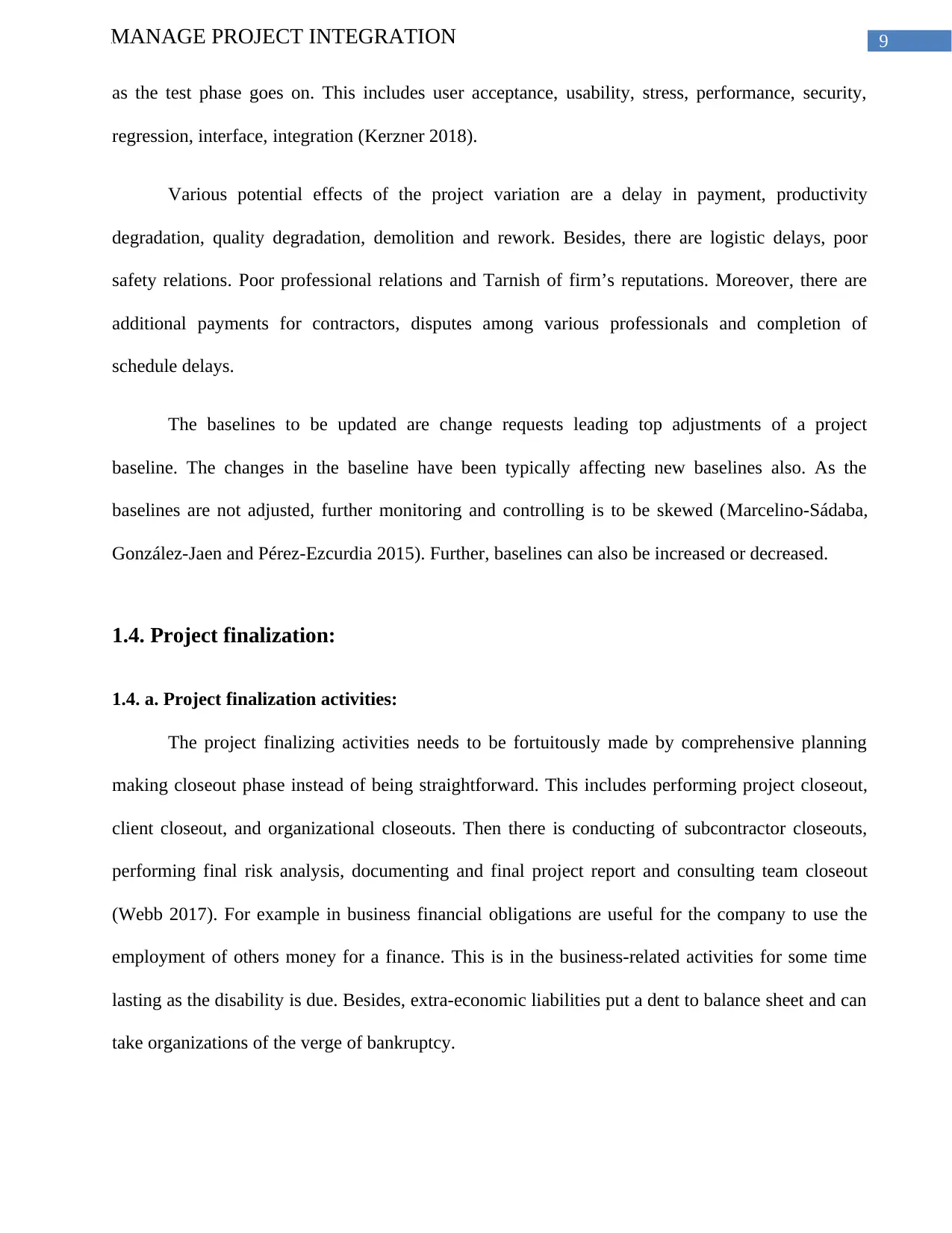
9MANAGE PROJECT INTEGRATION
as the test phase goes on. This includes user acceptance, usability, stress, performance, security,
regression, interface, integration (Kerzner 2018).
Various potential effects of the project variation are a delay in payment, productivity
degradation, quality degradation, demolition and rework. Besides, there are logistic delays, poor
safety relations. Poor professional relations and Tarnish of firm’s reputations. Moreover, there are
additional payments for contractors, disputes among various professionals and completion of
schedule delays.
The baselines to be updated are change requests leading top adjustments of a project
baseline. The changes in the baseline have been typically affecting new baselines also. As the
baselines are not adjusted, further monitoring and controlling is to be skewed (Marcelino-Sádaba,
González-Jaen and Pérez-Ezcurdia 2015). Further, baselines can also be increased or decreased.
1.4. Project finalization:
1.4. a. Project finalization activities:
The project finalizing activities needs to be fortuitously made by comprehensive planning
making closeout phase instead of being straightforward. This includes performing project closeout,
client closeout, and organizational closeouts. Then there is conducting of subcontractor closeouts,
performing final risk analysis, documenting and final project report and consulting team closeout
(Webb 2017). For example in business financial obligations are useful for the company to use the
employment of others money for a finance. This is in the business-related activities for some time
lasting as the disability is due. Besides, extra-economic liabilities put a dent to balance sheet and can
take organizations of the verge of bankruptcy.
as the test phase goes on. This includes user acceptance, usability, stress, performance, security,
regression, interface, integration (Kerzner 2018).
Various potential effects of the project variation are a delay in payment, productivity
degradation, quality degradation, demolition and rework. Besides, there are logistic delays, poor
safety relations. Poor professional relations and Tarnish of firm’s reputations. Moreover, there are
additional payments for contractors, disputes among various professionals and completion of
schedule delays.
The baselines to be updated are change requests leading top adjustments of a project
baseline. The changes in the baseline have been typically affecting new baselines also. As the
baselines are not adjusted, further monitoring and controlling is to be skewed (Marcelino-Sádaba,
González-Jaen and Pérez-Ezcurdia 2015). Further, baselines can also be increased or decreased.
1.4. Project finalization:
1.4. a. Project finalization activities:
The project finalizing activities needs to be fortuitously made by comprehensive planning
making closeout phase instead of being straightforward. This includes performing project closeout,
client closeout, and organizational closeouts. Then there is conducting of subcontractor closeouts,
performing final risk analysis, documenting and final project report and consulting team closeout
(Webb 2017). For example in business financial obligations are useful for the company to use the
employment of others money for a finance. This is in the business-related activities for some time
lasting as the disability is due. Besides, extra-economic liabilities put a dent to balance sheet and can
take organizations of the verge of bankruptcy.
Paraphrase This Document
Need a fresh take? Get an instant paraphrase of this document with our AI Paraphraser
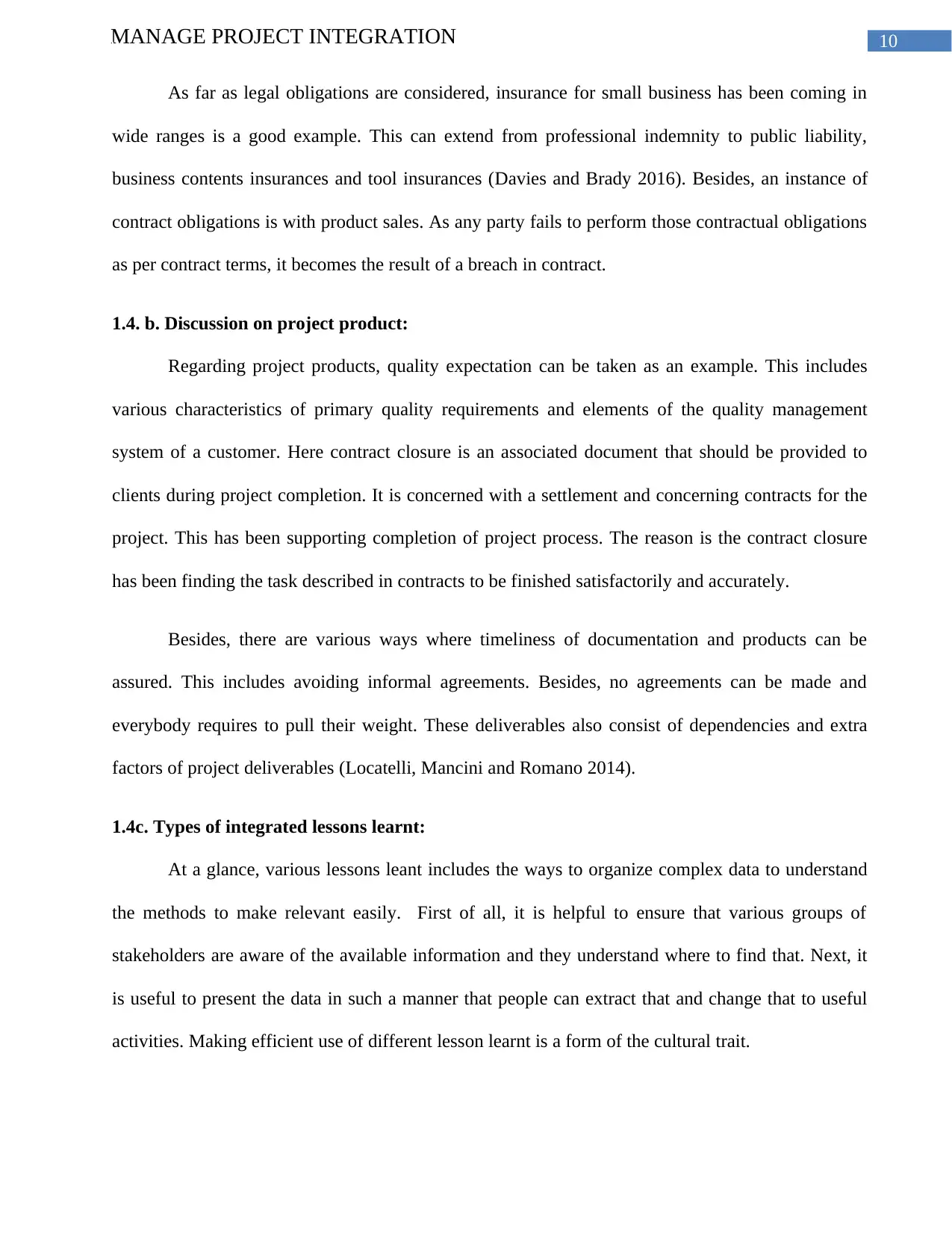
10MANAGE PROJECT INTEGRATION
As far as legal obligations are considered, insurance for small business has been coming in
wide ranges is a good example. This can extend from professional indemnity to public liability,
business contents insurances and tool insurances (Davies and Brady 2016). Besides, an instance of
contract obligations is with product sales. As any party fails to perform those contractual obligations
as per contract terms, it becomes the result of a breach in contract.
1.4. b. Discussion on project product:
Regarding project products, quality expectation can be taken as an example. This includes
various characteristics of primary quality requirements and elements of the quality management
system of a customer. Here contract closure is an associated document that should be provided to
clients during project completion. It is concerned with a settlement and concerning contracts for the
project. This has been supporting completion of project process. The reason is the contract closure
has been finding the task described in contracts to be finished satisfactorily and accurately.
Besides, there are various ways where timeliness of documentation and products can be
assured. This includes avoiding informal agreements. Besides, no agreements can be made and
everybody requires to pull their weight. These deliverables also consist of dependencies and extra
factors of project deliverables (Locatelli, Mancini and Romano 2014).
1.4c. Types of integrated lessons learnt:
At a glance, various lessons leant includes the ways to organize complex data to understand
the methods to make relevant easily. First of all, it is helpful to ensure that various groups of
stakeholders are aware of the available information and they understand where to find that. Next, it
is useful to present the data in such a manner that people can extract that and change that to useful
activities. Making efficient use of different lesson learnt is a form of the cultural trait.
As far as legal obligations are considered, insurance for small business has been coming in
wide ranges is a good example. This can extend from professional indemnity to public liability,
business contents insurances and tool insurances (Davies and Brady 2016). Besides, an instance of
contract obligations is with product sales. As any party fails to perform those contractual obligations
as per contract terms, it becomes the result of a breach in contract.
1.4. b. Discussion on project product:
Regarding project products, quality expectation can be taken as an example. This includes
various characteristics of primary quality requirements and elements of the quality management
system of a customer. Here contract closure is an associated document that should be provided to
clients during project completion. It is concerned with a settlement and concerning contracts for the
project. This has been supporting completion of project process. The reason is the contract closure
has been finding the task described in contracts to be finished satisfactorily and accurately.
Besides, there are various ways where timeliness of documentation and products can be
assured. This includes avoiding informal agreements. Besides, no agreements can be made and
everybody requires to pull their weight. These deliverables also consist of dependencies and extra
factors of project deliverables (Locatelli, Mancini and Romano 2014).
1.4c. Types of integrated lessons learnt:
At a glance, various lessons leant includes the ways to organize complex data to understand
the methods to make relevant easily. First of all, it is helpful to ensure that various groups of
stakeholders are aware of the available information and they understand where to find that. Next, it
is useful to present the data in such a manner that people can extract that and change that to useful
activities. Making efficient use of different lesson learnt is a form of the cultural trait.
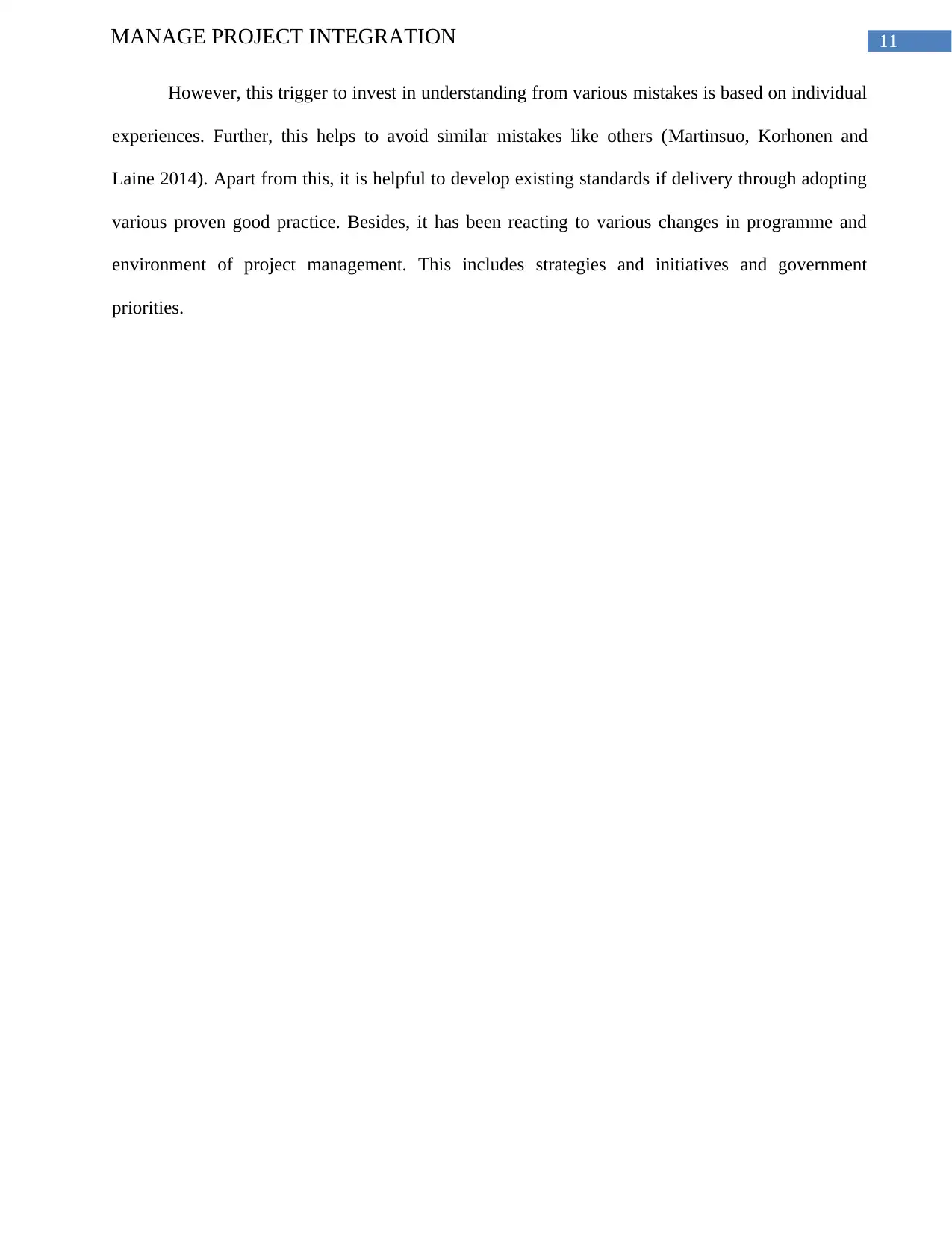
11MANAGE PROJECT INTEGRATION
However, this trigger to invest in understanding from various mistakes is based on individual
experiences. Further, this helps to avoid similar mistakes like others (Martinsuo, Korhonen and
Laine 2014). Apart from this, it is helpful to develop existing standards if delivery through adopting
various proven good practice. Besides, it has been reacting to various changes in programme and
environment of project management. This includes strategies and initiatives and government
priorities.
However, this trigger to invest in understanding from various mistakes is based on individual
experiences. Further, this helps to avoid similar mistakes like others (Martinsuo, Korhonen and
Laine 2014). Apart from this, it is helpful to develop existing standards if delivery through adopting
various proven good practice. Besides, it has been reacting to various changes in programme and
environment of project management. This includes strategies and initiatives and government
priorities.
⊘ This is a preview!⊘
Do you want full access?
Subscribe today to unlock all pages.

Trusted by 1+ million students worldwide
1 out of 14
Related Documents
Your All-in-One AI-Powered Toolkit for Academic Success.
+13062052269
info@desklib.com
Available 24*7 on WhatsApp / Email
![[object Object]](/_next/static/media/star-bottom.7253800d.svg)
Unlock your academic potential
Copyright © 2020–2025 A2Z Services. All Rights Reserved. Developed and managed by ZUCOL.




